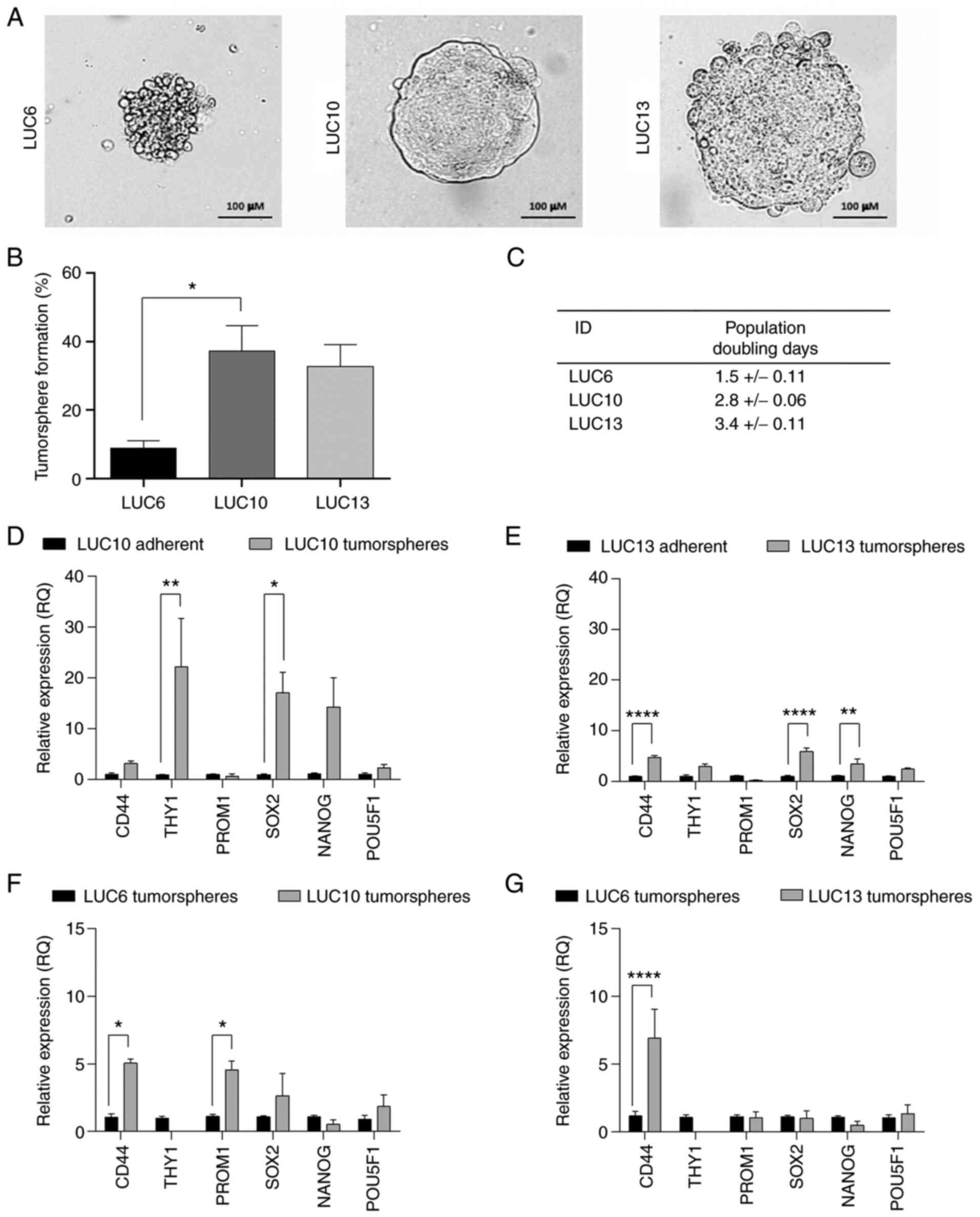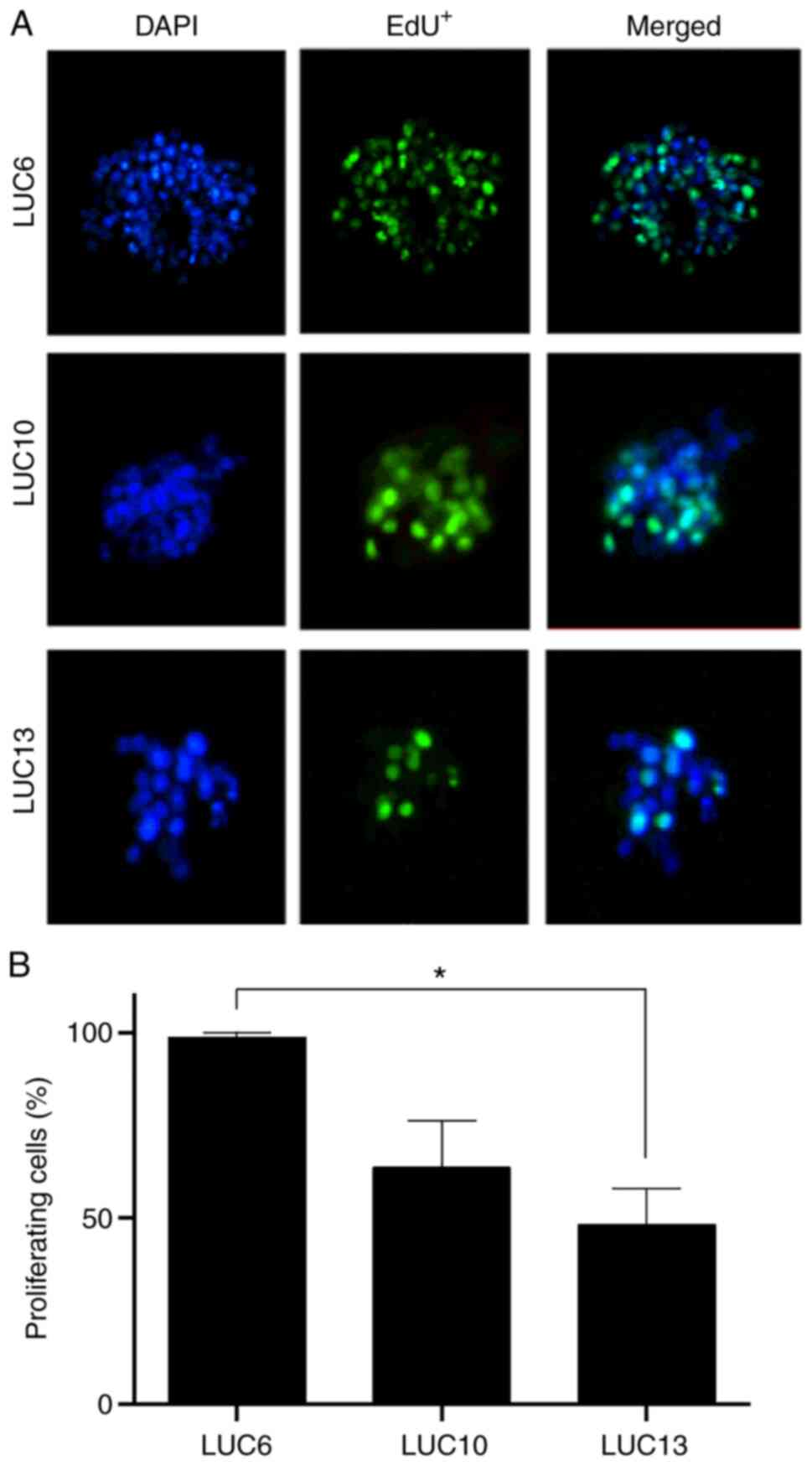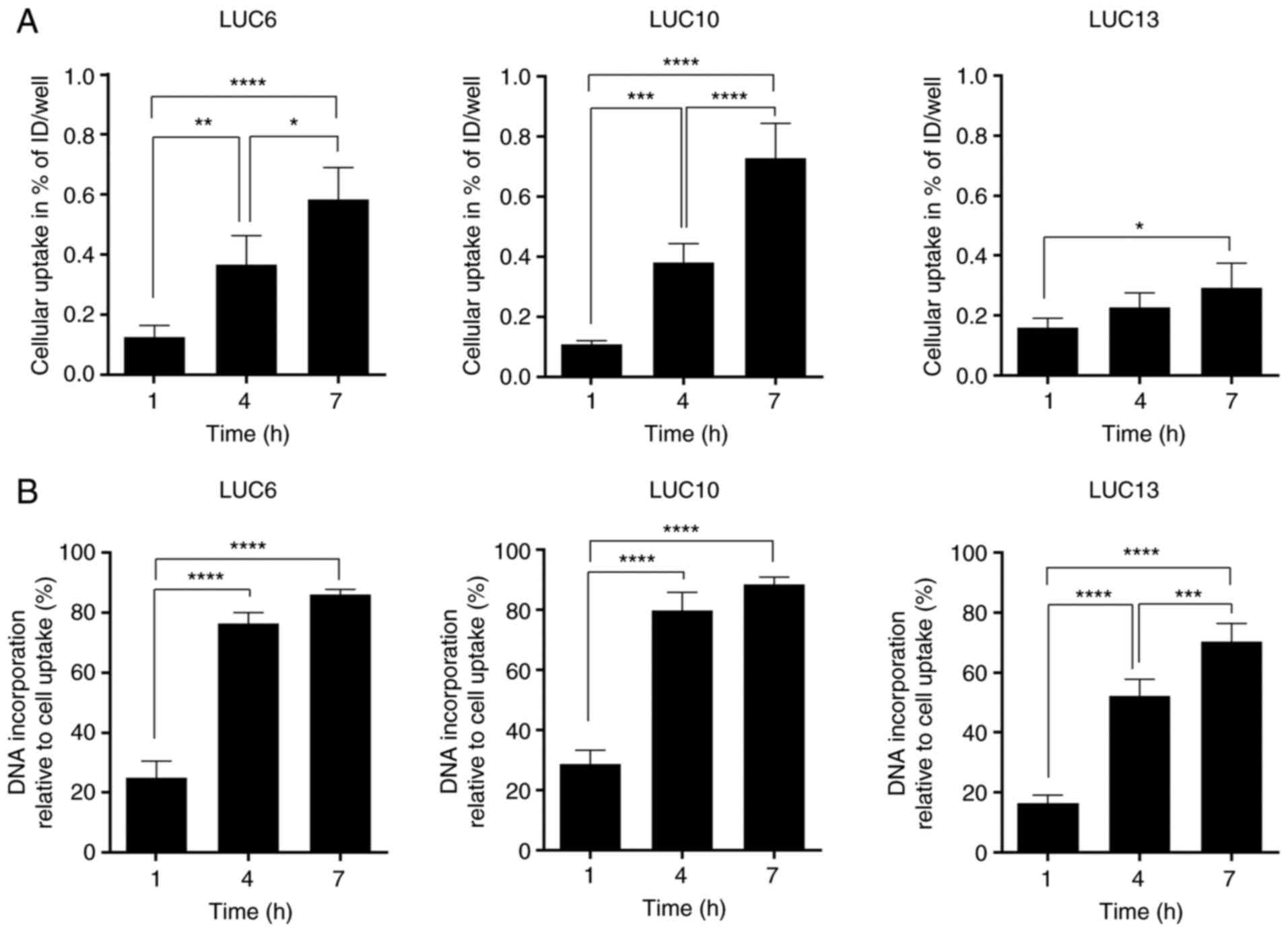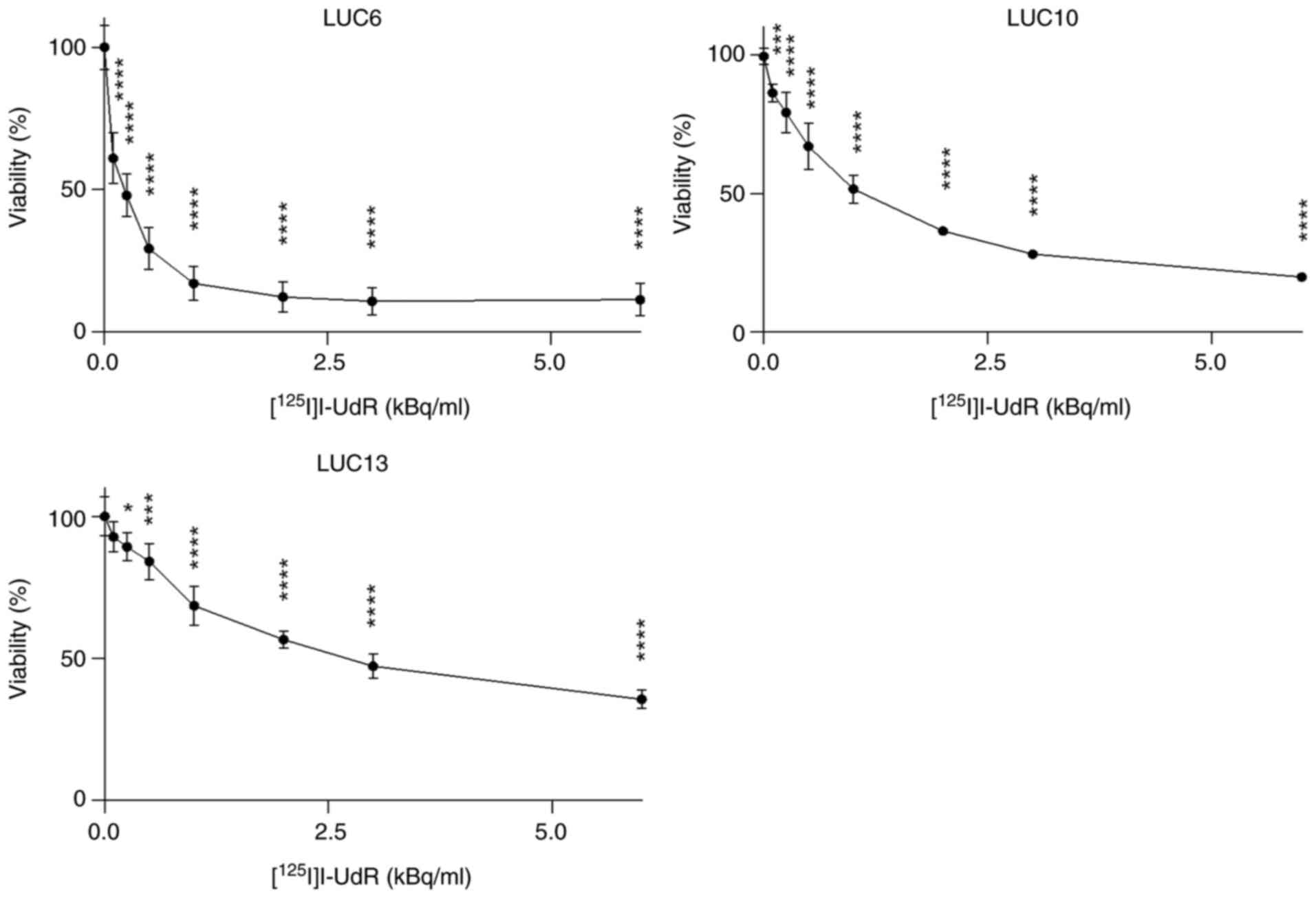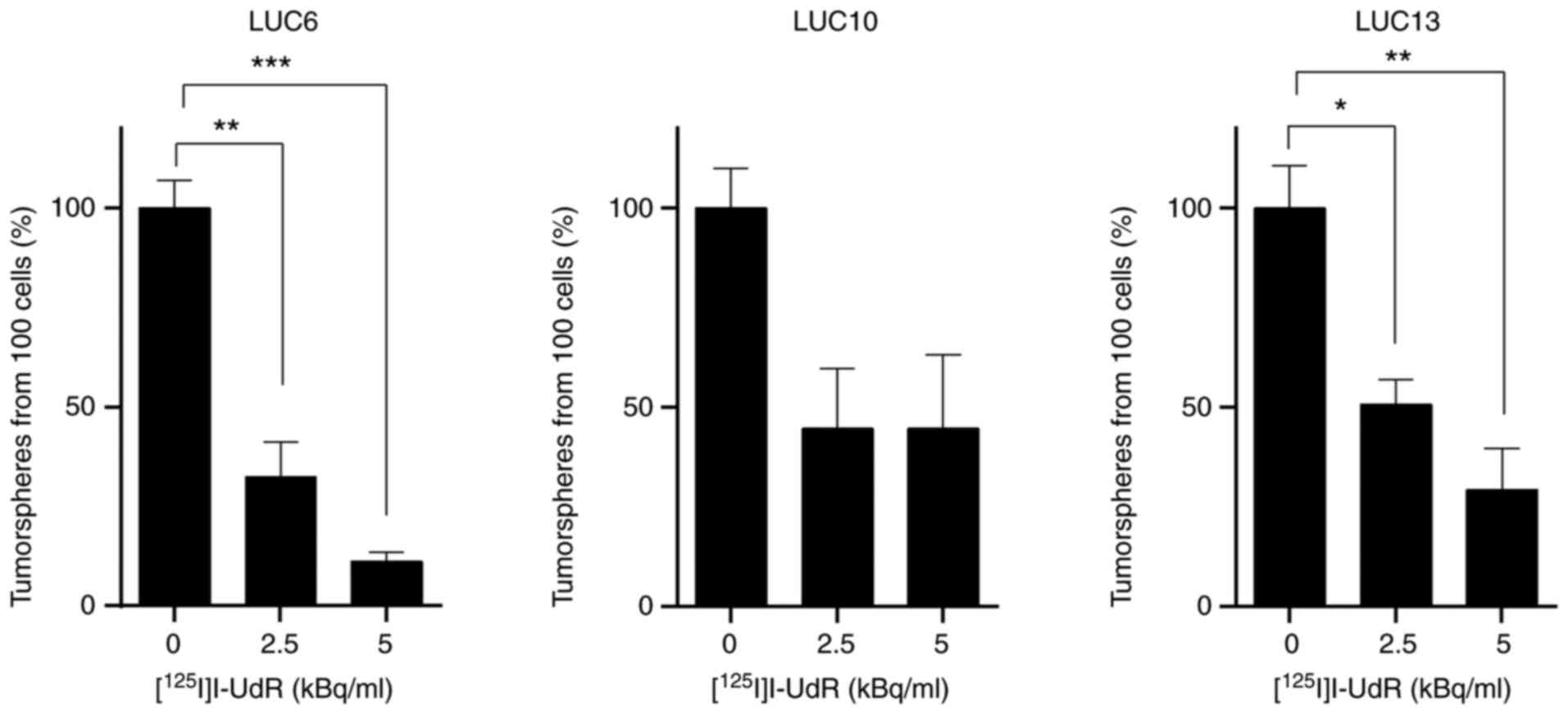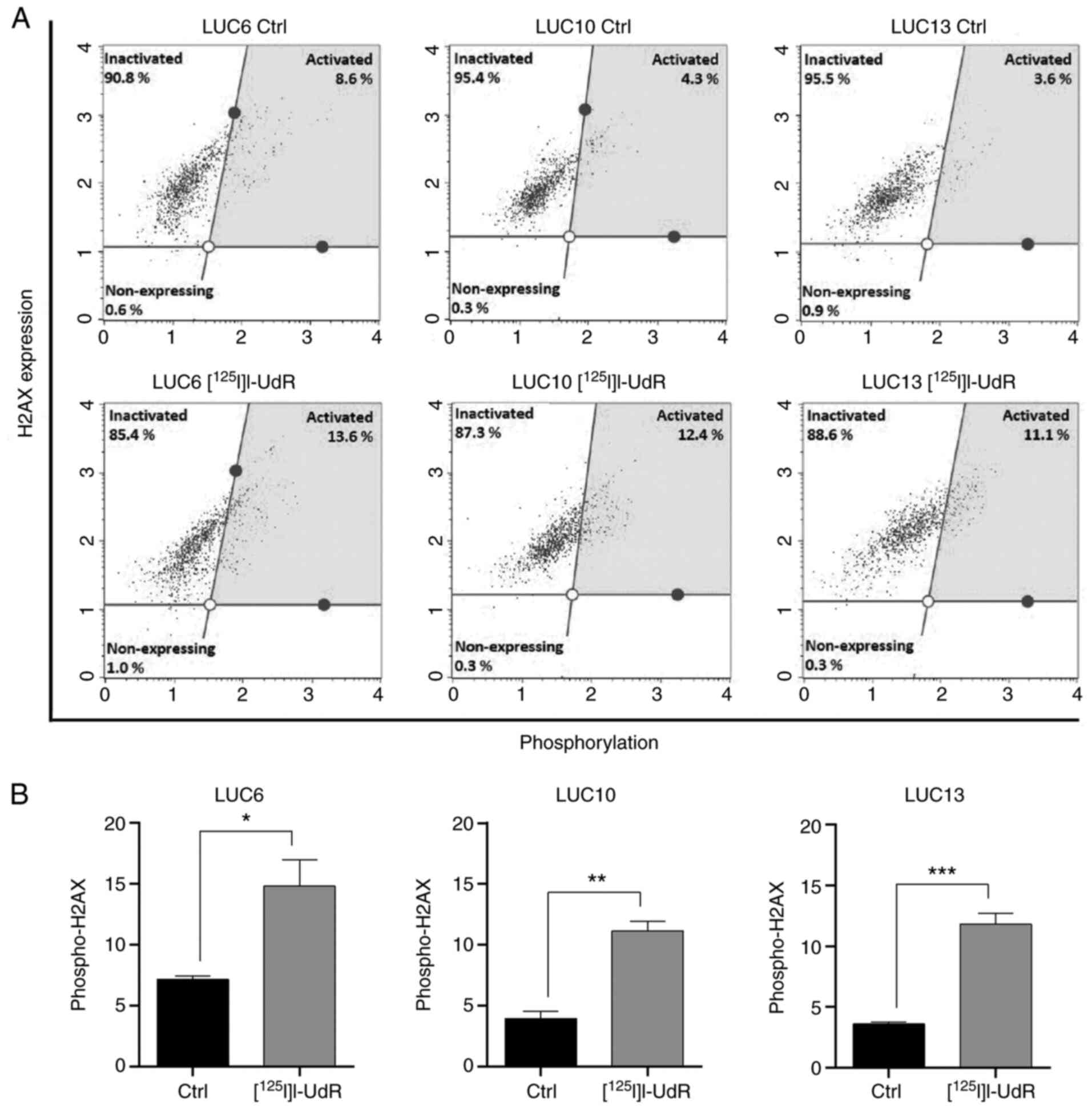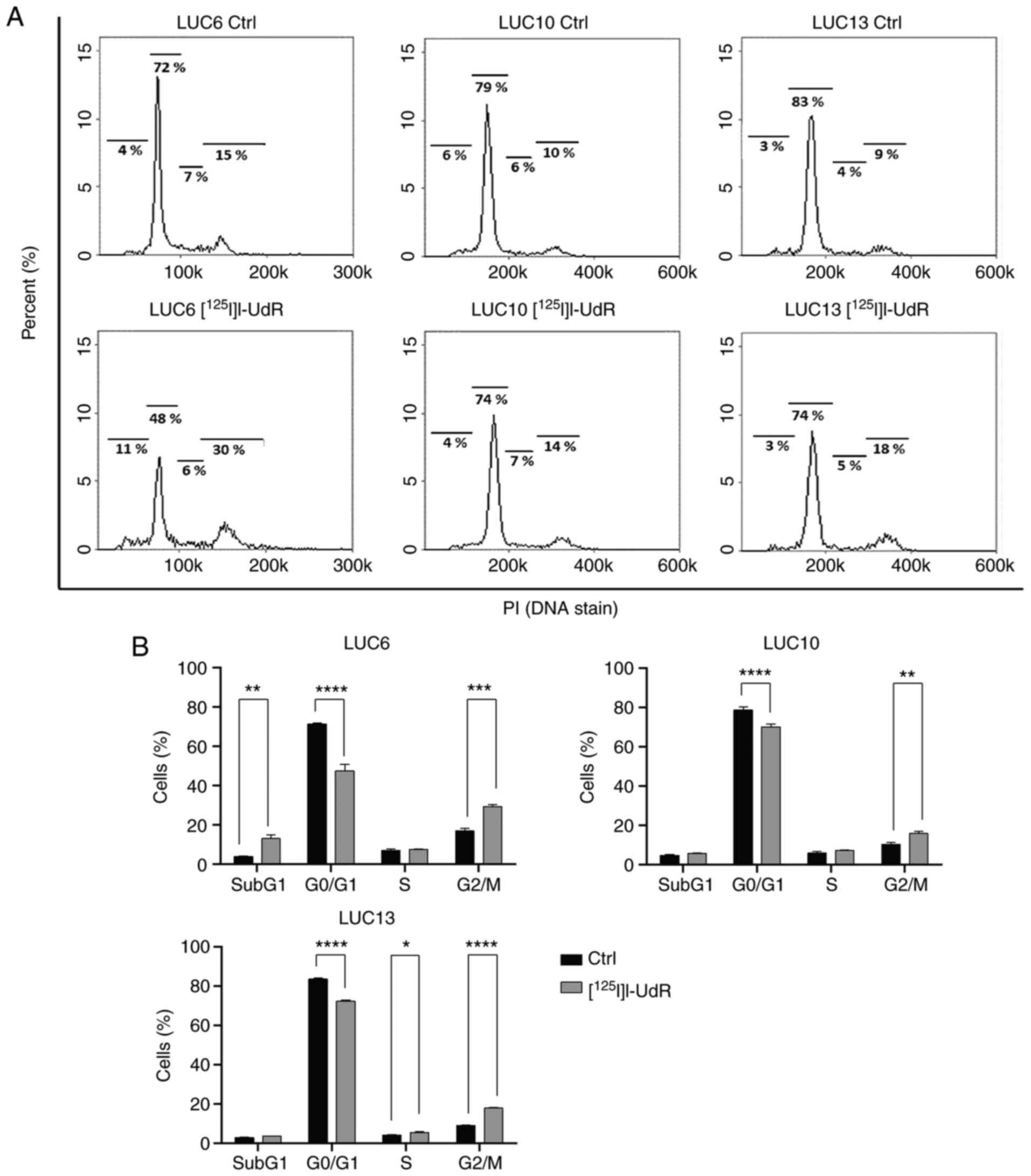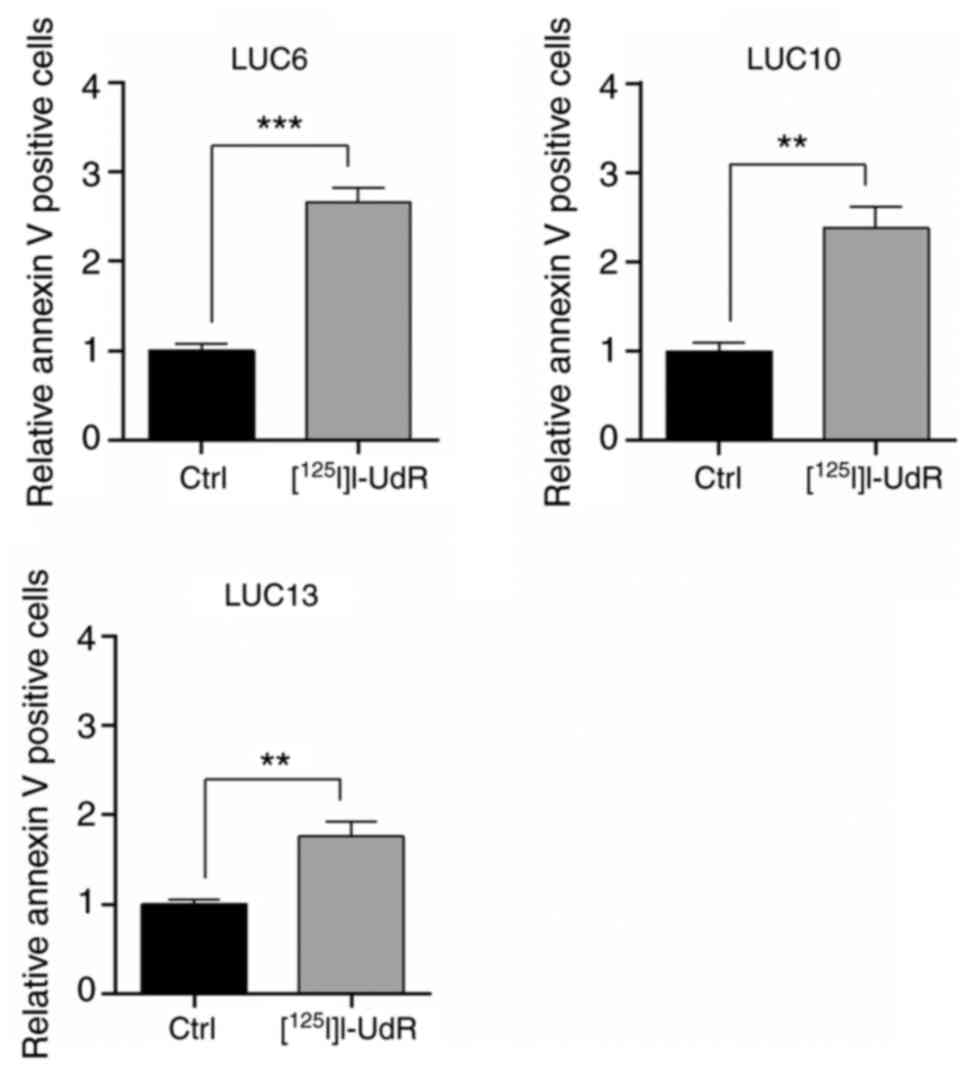|
1
|
Sung H, Ferlay J, Siegel RL, Laversanne M,
Soerjomataram I, Jemal A and Bray F: Global cancer statistics 2020:
GLOBOCAN estimates of incidence and mortality worldwide for 36
cancers in 185 countries. CA Cancer J Clin. 71:209–249. 2021.
View Article : Google Scholar : PubMed/NCBI
|
|
2
|
Heng WS, Gosens R and Kruyt FAE: Lung
cancer stem cells: Origin, features, maintenance mechanisms and
therapeutic targeting. Biochem Pharmacol. 160:121–133. 2019.
View Article : Google Scholar : PubMed/NCBI
|
|
3
|
Chen J, Xu J, Wan T, Deng H and Li D:
High-sensitive detection of small-cell lung cancer cells based on
terminal deoxynucleotidyl transferase-mediated extension
polymerization aptamer probe. ACS Biomater Sci Eng. 7:1169–1180.
2021. View Article : Google Scholar : PubMed/NCBI
|
|
4
|
Travis WD: Pathology of lung cancer. Clin
Chest Med. 32:669–692. 2011. View Article : Google Scholar : PubMed/NCBI
|
|
5
|
Leonetti A, Sharma S, Minari R, Perego P,
Giovannetti E and Tiseo M: Resistance mechanisms to osimertinib in
EGFR-mutated non-small cell lung cancer. Br J Cancer. 121:725–737.
2019. View Article : Google Scholar : PubMed/NCBI
|
|
6
|
MacDonagh L, Gray SG, Breen E, Cuffe S,
Finn SP, O'Byrne KJ and Barr MP: Lung cancer stem cells: The root
of resistance. Cancer Lett. 372:147–156. 2016. View Article : Google Scholar : PubMed/NCBI
|
|
7
|
Prabavathy D, Swarnalatha Y and Ramadoss
N: Lung cancer stem cells-origin, characteristics and therapy. Stem
Cell Investig. 5:62018. View Article : Google Scholar : PubMed/NCBI
|
|
8
|
Wang J, Sun Z, Liu Y, Kong L, Zhou S, Tang
J and Xing HR: Comparison of tumor biology of two distinct cell
sub-populations in lung cancer stem cells. Oncotarget.
8:96852–96864. 2017. View Article : Google Scholar : PubMed/NCBI
|
|
9
|
Singh SK, Clarke ID, Terasaki M, Bonn VE,
Hawkins C, Squire J and Dirks PB: Identification of a cancer stem
cell in human brain tumors. Cancer Res. 63:5821–5828.
2003.PubMed/NCBI
|
|
10
|
Al-Hajj M, Wicha MS, Benito-Hernandez A,
Morrison SJ and Clarke MF: Prospective identification of
tumorigenic breast cancer cells. Proc Natl Acad Sci USA.
100:3983–3988. 2003. View Article : Google Scholar : PubMed/NCBI
|
|
11
|
O'Brien CA, Pollett A, Gallinger S and
Dick JE: A human colon cancer cell capable of initiating tumour
growth in immunodeficient mice. Nature. 445:106–110. 2007.
View Article : Google Scholar : PubMed/NCBI
|
|
12
|
Collins AT, Berry PA, Hyde C, Stower MJ
and Maitland NJ: Prospective identification of tumorigenic prostate
cancer stem cells. Cancer Res. 65:10946–10951. 2005. View Article : Google Scholar : PubMed/NCBI
|
|
13
|
Kim CF, Jackson EL, Woolfenden AE,
Lawrence S, Babar I, Vogel S, Crowley D, Bronson RT and Jacks T:
Identification of bronchioalveolar stem cells in normal lung and
lung cancer. Cell. 121:823–835. 2005. View Article : Google Scholar : PubMed/NCBI
|
|
14
|
Raniszewska A, Kwiecień I, Rutkowska E,
Rzepecki P and Domagala-Kulawik J: Lung cancer stem cells-origin,
diagnostic techniques and perspective for therapies. Cancers
(Basel). 13:29962021. View Article : Google Scholar : PubMed/NCBI
|
|
15
|
Kassis AI: Molecular and cellular
radiobiological effects of Auger emitting radionuclides. Radiat
Prot Dosimetry. 143:241–247. 2011. View Article : Google Scholar : PubMed/NCBI
|
|
16
|
Pirovano G, Jannetti SA, Carter LM,
Sadique A, Kossatz S, Guru N, Demétrio De Souza França P, Maeda M,
Zeglis BM, Lewis JS, et al: Targeted brain tumor radiotherapy using
an Auger emitter. Clin Cancer Res. 26:2871–2881. 2020. View Article : Google Scholar : PubMed/NCBI
|
|
17
|
Morgenroth A, Vogg AT, Ermert K,
Zlatopolskiy B and Mottaghy FM: Hedgehog signaling sensitizes
glioma stem cells to endogenous nano-irradiation. Oncotarget.
5:5483–5493. 2014. View Article : Google Scholar : PubMed/NCBI
|
|
18
|
Chan C, Fonge H, Lam K and Reilly RM:
Effectiveness and normal tissue toxicity of Auger electron (AE)
radioimmunotherapy (RIT) with
[111In]In-Bn-DTPA-nimotuzumab in mice with
triple-negative or trastuzumab-resistant human breast cancer
xenografts that overexpress EGFR. Nucl Med Biol. 80-81:37–44. 2020.
View Article : Google Scholar : PubMed/NCBI
|
|
19
|
Morgenroth A, Vogg AT, Zlatopolskiy BD,
Siluschek M, Oedekoven C and Mottaghy FM: Breaking the
invulnerability of cancer stem cells: Two-step strategy to kill the
stem-like cell subpopulation of multiple myeloma. Mol Cancer Ther.
13:144–153. 2014. View Article : Google Scholar : PubMed/NCBI
|
|
20
|
Balagurumoorthy P, Xu X, Wang K, Adelstein
SJ and Kassis AI: Effect of distance between decaying (125)I and
DNA on Auger-electron induced double-strand break yield. Int J
Radiat Biol. 88:998–1008. 2012. View Article : Google Scholar : PubMed/NCBI
|
|
21
|
Thisgaard H, Halle B, Aaberg-Jessen C,
Olsen BB, Therkelsen AS, Dam JH, Langkjær N, Munthe S, Någren K,
Høilund-Carlsen PF and Kristensen BW: Highly effective
Auger-electron therapy in an orthotopic glioblastoma xenograft
model using convection-enhanced delivery. Theranostics.
6:2278–2291. 2016. View Article : Google Scholar : PubMed/NCBI
|
|
22
|
Herreros-Pomares A, de-Maya-Girones JD,
Calabuig-Fariñas S, Lucas R, Martínez A, Pardo-Sánchez JM, Alonso
S, Blasco A, Guijarro R, Martorell M, et al: Lung tumorspheres
reveal cancer stem cell-like properties and a score with prognostic
impact in resected non-small-cell lung cancer. Cell Death Dis.
10:6602019. View Article : Google Scholar : PubMed/NCBI
|
|
23
|
Lee J, Kotliarova S, Kotliarov Y, Li A, Su
Q, Donin NM, Pastorino S, Purow BW, Christopher N, Zhang W, et al:
Tumor stem cells derived from glioblastomas cultured in bFGF and
EGF more closely mirror the phenotype and genotype of primary
tumors than do serum-cultured cell lines. Cancer Cell. 9:391–403.
2006. View Article : Google Scholar : PubMed/NCBI
|
|
24
|
Xie F, Xiao P, Chen D, Xu L and Zhang B:
miRDeepFinder: A miRNA analysis tool for deep sequencing of plant
small RNAs. Plant Mol Biol. Jan 31–2012.(Epub ahead of print).
View Article : Google Scholar
|
|
25
|
Livak KJ and Schmittgen TD: Analysis of
relative gene expression data using real-time quantitative PCR and
the 2(−Delta Delta C(T)) method. Methods. 25:402–408. 2001.
View Article : Google Scholar : PubMed/NCBI
|
|
26
|
Madsen KL, Therkelsen ASN, Langkjær N,
Olsen BB and Thisgaard H: Auger electron therapy of glioblastoma
using [125I]5-iodo-2′-deoxyuridine and concomitant
chemotherapy-evaluation of a potential treatment strategy. Nucl Med
Biol. 96-97:35–40. 2021. View Article : Google Scholar : PubMed/NCBI
|
|
27
|
Shigdar S, Lin J, Li Y, Yang CJ, Wei M,
Zhus Y, Liu H and Duan W: Cancer stem cell targeting: The next
generation of cancer therapy and molecular imaging. Ther Deliv.
3:227–244. 2012. View Article : Google Scholar : PubMed/NCBI
|
|
28
|
Lawrence TS, Davis MA, Maybaum J, Stetson
PL and Ensminger WD: The effect of single versus double-strand
substitution on halogenated pyrimidine-induced radiosensitization
and DNA strand breakage in human tumor cells. Radiat Res.
123:192–198. 1990. View Article : Google Scholar : PubMed/NCBI
|
|
29
|
Dupertuis YM, Vazquez M, Mach JP, De
Tribolet N, Pichard C, Slosman DO and Buchegger F:
Fluorodeoxyuridine improves imaging of human glioblastoma
xenografts with radiolabeled iododeoxyuridine. Cancer Res.
61:7971–7977. 2001.PubMed/NCBI
|
|
30
|
Rogakou EP, Pilch DR, Orr AH, Ivanova VS
and Bonner WM: DNA double-stranded breaks induce histone H2AX
phosphorylation on serine 139. J Biol Chem. 273:5858–5868. 1998.
View Article : Google Scholar : PubMed/NCBI
|
|
31
|
Rothkamm K, Krüger I, Thompson LH and
Löbrich M: Pathways of DNA double-strand break repair during the
mammalian cell cycle. Mol Cell Biol. 23:5706–5715. 2003. View Article : Google Scholar : PubMed/NCBI
|
|
32
|
Lv D, Hu Z, Lu L, Lu H and Xu X:
Three-dimensional cell culture: A powerful tool in tumor research
and drug discovery. Oncol Lett. 14:6999–7010. 2017.PubMed/NCBI
|
|
33
|
Eramo A, Lotti F, Sette G, Pilozzi E,
Biffoni M, Di Virgilio A, Conticello C, Ruco L, Peschle C and De
Maria R: Identification and expansion of the tumorigenic lung
cancer stem cell population. Cell Death Differ. 15:504–514. 2008.
View Article : Google Scholar : PubMed/NCBI
|
|
34
|
Qiu X, Wang Z, Li Y, Miao Y, Ren Y and
Luan Y: Characterization of sphere-forming cells with stem-like
properties from the small cell lung cancer cell line H446. Cancer
Lett. 323:161–170. 2012. View Article : Google Scholar : PubMed/NCBI
|
|
35
|
Bertolini G, Roz L, Perego P, Tortoreto M,
Fontanella E, Gatti L, Pratesi G, Fabbri A, Andriani F, Tinelli S,
et al: Highly tumorigenic lung cancer CD133+ cells display
stem-like features and are spared by cisplatin treatment. Proc Natl
Acad Sci USA. 106:16281–16286. 2009. View Article : Google Scholar : PubMed/NCBI
|
|
36
|
Pece S, Tosoni D, Confalonieri S, Mazzarol
G, Vecchi M, Ronzoni S, Bernard L, Viale G, Pelicci PG and Di Fiore
PP: Biological and molecular heterogeneity of breast cancers
correlates with their cancer stem cell content. Cell. 140:62–73.
2010. View Article : Google Scholar : PubMed/NCBI
|
|
37
|
Kim SY, Lee JY, Kim DH, Joo HS, Yun MR,
Jung D, Yun J, Heo SG, Ahn BC, Park CW, et al: Patient-derived
cells to guide targeted therapy for advanced lung adenocarcinoma.
Sci Rep. 9:199092019. View Article : Google Scholar : PubMed/NCBI
|
|
38
|
Yeon SE, No da Y, Lee SH, Nam SW, Oh IH,
Lee J and Kuh HJ: Application of concave microwells to pancreatic
tumor spheroids enabling anticancer drug evaluation in a clinically
relevant drug resistance model. PLoS One. 8:e733452013. View Article : Google Scholar : PubMed/NCBI
|
|
39
|
Roesch A, Fukunaga-Kalabis M, Schmidt EC,
Zabierowski SE, Brafford PA, Vultur A, Basu D, Gimotty P, Vogt T
and Herlyn M: A temporarily distinct subpopulation of slow-cycling
melanoma cells is required for continuous tumor growth. Cell.
141:583–594. 2010. View Article : Google Scholar : PubMed/NCBI
|
|
40
|
Park E, Park SY, Sun PL, Jin Y, Kim JE,
Jheon S, Kim K, Lee CT, Kim H and Chung JH: Prognostic significance
of stem cell-related marker expression and its correlation with
histologic subtypes in lung adenocarcinoma. Oncotarget.
7:42502–42512. 2016. View Article : Google Scholar : PubMed/NCBI
|
|
41
|
Plotnik DA, Emerick LE, Krohn KA, Unadkat
JD and Schwartz JL: Different modes of transport for 3H-thymidine,
3H-FLT, and 3H-FMAU in proliferating and nonproliferating human
tumor cells. J Nucl Med. 51:1464–1471. 2010. View Article : Google Scholar : PubMed/NCBI
|
|
42
|
Tsunekuni K, Konno M, Haraguchi N, Koseki
J, Asai A, Matsuoka K, Kobunai T, Takechi T, Doki Y, Mori M and
Ishii H: CD44/CD133-positive colorectal cancer stem cells are
sensitive to trifluridine exposure. Sci Rep. 9:148612019.
View Article : Google Scholar : PubMed/NCBI
|
|
43
|
Eriksson D and Stigbrand T:
Radiation-induced cell death mechanisms. Tumour Biol. 31:363–372.
2010. View Article : Google Scholar : PubMed/NCBI
|
|
44
|
Al-Assar O, Muschel RJ, Mantoni TS,
McKenna WG and Brunner TB: Radiation response of cancer stem-like
cells from established human cell lines after sorting for surface
markers. Int J Radiat Oncol Biol Phys. 75:1216–1225. 2009.
View Article : Google Scholar : PubMed/NCBI
|
|
45
|
Ghisolfi L, Keates AC, Hu X, Lee DK and Li
CJ: Ionizing radiation induces stemness in cancer cells. PLoS One.
7:e436282012. View Article : Google Scholar : PubMed/NCBI
|
|
46
|
Lagadec C, Vlashi E, Della Donna L,
Dekmezian C and Pajonk F: Radiation-induced reprogramming of breast
cancer cells. Stem Cells. 30:833–844. 2012. View Article : Google Scholar : PubMed/NCBI
|
|
47
|
Wang Y, Li W, Patel SS, Cong J, Zhang N,
Sabbatino F, Liu X, Qi Y, Huang P, Lee H, et al: Blocking the
formation of radiation-induced breast cancer stem cells.
Oncotarget. 5:3743–3755. 2014. View Article : Google Scholar : PubMed/NCBI
|















